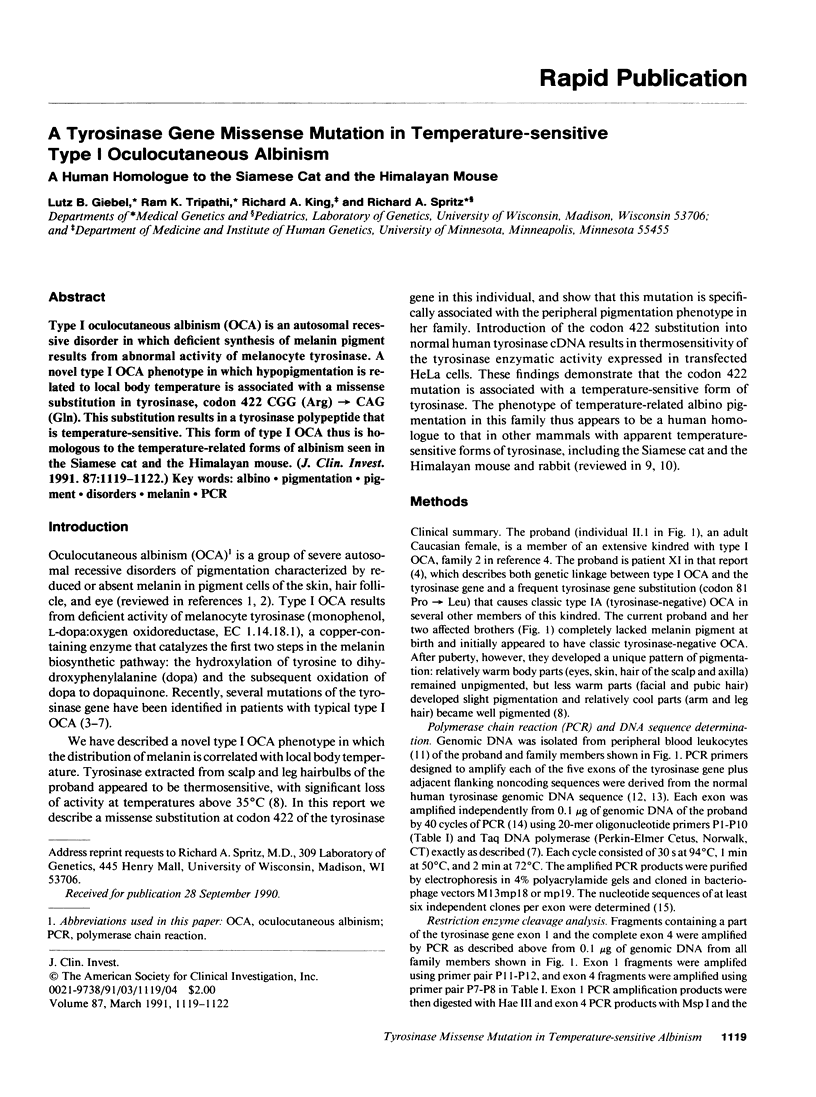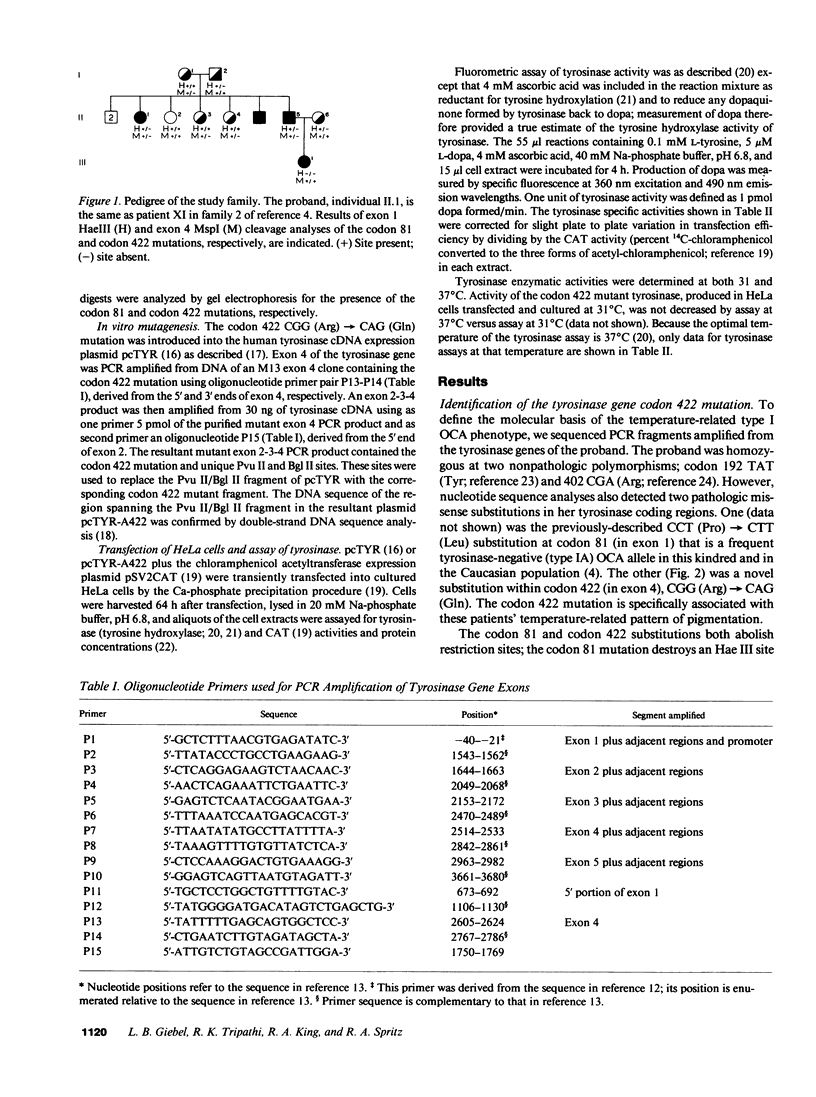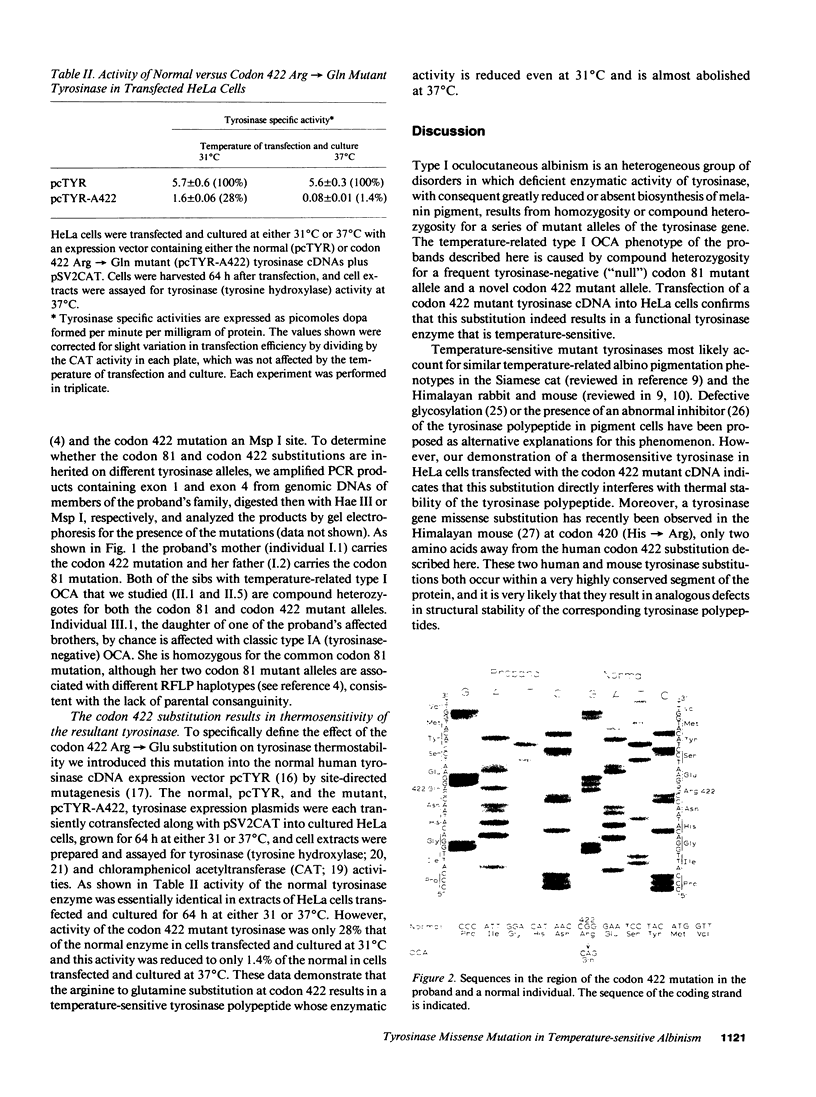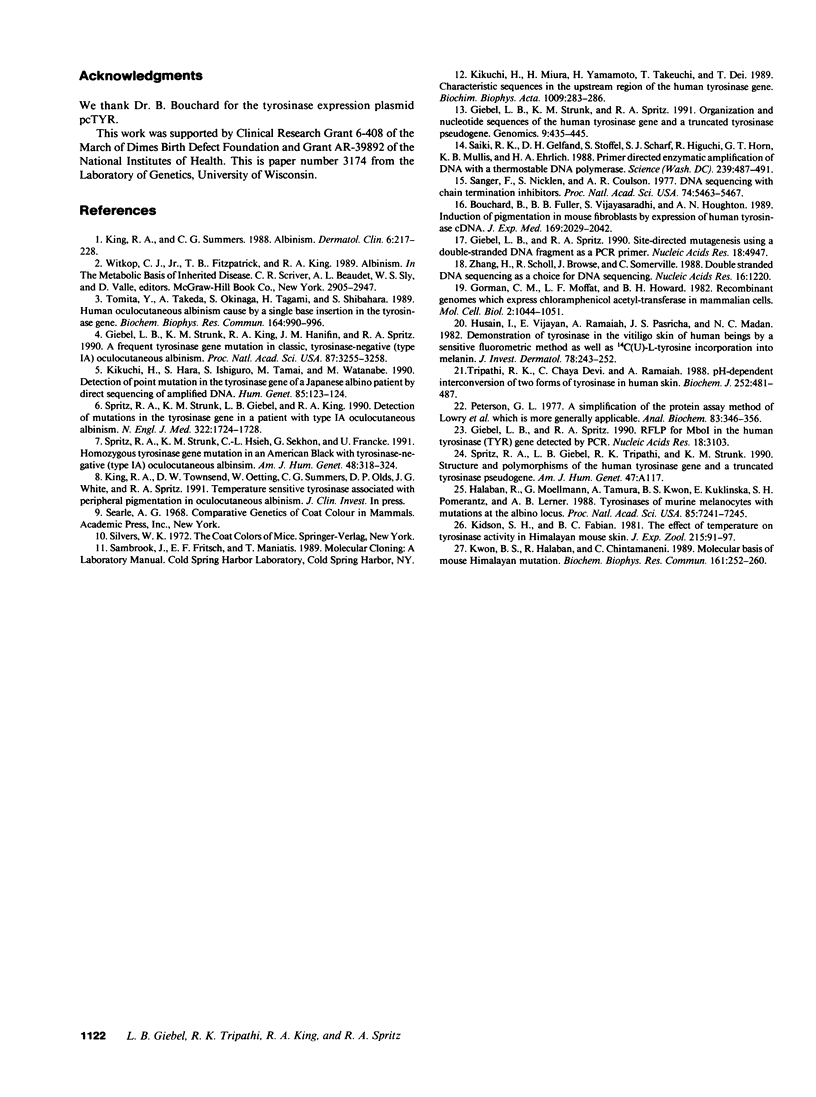Abstract
Type I oculocutaneous albinism (OCA) is an autosomal recessive disorder in which deficient synthesis of melanin pigment results from abnormal activity of melanocyte tyrosinase. A novel type I OCA phenotype in which hypopigmentation is related to local body temperature is associated with a missense substitution in tyrosinase, codon 422 CGG (Arg)----CAG (Gln). This substitution results in a tyrosinase polypeptide that is temperature-sensitive. This form of type I OCA thus is homologous to the temperature-related forms of albinism seen in the Siamese cat and the Himalayan mouse.
Full text
PDF



Images in this article
Selected References
These references are in PubMed. This may not be the complete list of references from this article.
- Bouchard B., Fuller B. B., Vijayasaradhi S., Houghton A. N. Induction of pigmentation in mouse fibroblasts by expression of human tyrosinase cDNA. J Exp Med. 1989 Jun 1;169(6):2029–2042. doi: 10.1084/jem.169.6.2029. [DOI] [PMC free article] [PubMed] [Google Scholar]
- Giebel L. B., Spritz R. A. RFLP for MboI in the human tyrosinase (TYR) gene detected by PCR. Nucleic Acids Res. 1990 May 25;18(10):3103–3103. doi: 10.1093/nar/18.10.3103-a. [DOI] [PMC free article] [PubMed] [Google Scholar]
- Giebel L. B., Spritz R. A. Site-directed mutagenesis using a double-stranded DNA fragment as a PCR primer. Nucleic Acids Res. 1990 Aug 25;18(16):4947–4947. doi: 10.1093/nar/18.16.4947. [DOI] [PMC free article] [PubMed] [Google Scholar]
- Giebel L. B., Strunk K. M., King R. A., Hanifin J. M., Spritz R. A. A frequent tyrosinase gene mutation in classic, tyrosinase-negative (type IA) oculocutaneous albinism. Proc Natl Acad Sci U S A. 1990 May;87(9):3255–3258. doi: 10.1073/pnas.87.9.3255. [DOI] [PMC free article] [PubMed] [Google Scholar]
- Giebel L. B., Strunk K. M., Spritz R. A. Organization and nucleotide sequences of the human tyrosinase gene and a truncated tyrosinase-related segment. Genomics. 1991 Mar;9(3):435–445. doi: 10.1016/0888-7543(91)90409-8. [DOI] [PubMed] [Google Scholar]
- Gorman C. M., Moffat L. F., Howard B. H. Recombinant genomes which express chloramphenicol acetyltransferase in mammalian cells. Mol Cell Biol. 1982 Sep;2(9):1044–1051. doi: 10.1128/mcb.2.9.1044. [DOI] [PMC free article] [PubMed] [Google Scholar]
- Halaban R., Moellmann G., Tamura A., Kwon B. S., Kuklinska E., Pomerantz S. H., Lerner A. B. Tyrosinases of murine melanocytes with mutations at the albino locus. Proc Natl Acad Sci U S A. 1988 Oct;85(19):7241–7245. doi: 10.1073/pnas.85.19.7241. [DOI] [PMC free article] [PubMed] [Google Scholar]
- Husain I., Vijayan E., Ramaiah A., Pasricha J. S., Madan N. C. Demonstration of tyrosinase in the vitiligo skin of human beings by a sensitive fluorometric method as well as by 14C(U)-L-tyrosine incorporation into melanin. J Invest Dermatol. 1982 Mar;78(3):243–252. doi: 10.1111/1523-1747.ep12506603. [DOI] [PubMed] [Google Scholar]
- Kidson S. H., Fabian B. C. The effect of temperature on tyrosinase activity in Himalayan mouse skin. J Exp Zool. 1981 Jan;215(1):91–97. doi: 10.1002/jez.1402150111. [DOI] [PubMed] [Google Scholar]
- Kikuchi H., Hara S., Ishiguro S., Tamai M., Watanabe M. Detection of point mutation in the tyrosinase gene of a Japanese albino patient by a direct sequencing of amplified DNA. Hum Genet. 1990 Jun;85(1):123–124. doi: 10.1007/BF00276337. [DOI] [PubMed] [Google Scholar]
- Kikuchi H., Miura H., Yamamoto H., Takeuchi T., Dei T., Watanabe M. Characteristic sequences in the upstream region of the human tyrosinase gene. Biochim Biophys Acta. 1989 Dec 22;1009(3):283–286. doi: 10.1016/0167-4781(89)90115-2. [DOI] [PubMed] [Google Scholar]
- King R. A., Summers C. G. Albinism. Dermatol Clin. 1988 Apr;6(2):217–228. [PubMed] [Google Scholar]
- Kwon B. S., Halaban R., Chintamaneni C. Molecular basis of mouse Himalayan mutation. Biochem Biophys Res Commun. 1989 May 30;161(1):252–260. doi: 10.1016/0006-291x(89)91588-x. [DOI] [PubMed] [Google Scholar]
- Peterson G. L. A simplification of the protein assay method of Lowry et al. which is more generally applicable. Anal Biochem. 1977 Dec;83(2):346–356. doi: 10.1016/0003-2697(77)90043-4. [DOI] [PubMed] [Google Scholar]
- Saiki R. K., Gelfand D. H., Stoffel S., Scharf S. J., Higuchi R., Horn G. T., Mullis K. B., Erlich H. A. Primer-directed enzymatic amplification of DNA with a thermostable DNA polymerase. Science. 1988 Jan 29;239(4839):487–491. doi: 10.1126/science.2448875. [DOI] [PubMed] [Google Scholar]
- Sanger F., Nicklen S., Coulson A. R. DNA sequencing with chain-terminating inhibitors. Proc Natl Acad Sci U S A. 1977 Dec;74(12):5463–5467. doi: 10.1073/pnas.74.12.5463. [DOI] [PMC free article] [PubMed] [Google Scholar]
- Spritz R. A., Strunk K. M., Giebel L. B., King R. A. Detection of mutations in the tyrosinase gene in a patient with type IA oculocutaneous albinism. N Engl J Med. 1990 Jun 14;322(24):1724–1728. doi: 10.1056/NEJM199006143222407. [DOI] [PubMed] [Google Scholar]
- Spritz R. A., Strunk K. M., Hsieh C. L., Sekhon G. S., Francke U. Homozygous tyrosinase gene mutation in an American black with tyrosinase-negative (type IA) oculocutaneous albinism. Am J Hum Genet. 1991 Feb;48(2):318–324. [PMC free article] [PubMed] [Google Scholar]
- Tomita Y., Takeda A., Okinaga S., Tagami H., Shibahara S. Human oculocutaneous albinism caused by single base insertion in the tyrosinase gene. Biochem Biophys Res Commun. 1989 Nov 15;164(3):990–996. doi: 10.1016/0006-291x(89)91767-1. [DOI] [PubMed] [Google Scholar]
- Tripathi R. K., Chaya Devi C., Ramaiah A. pH-dependent interconversion of two forms of tyrosinase in human skin. Biochem J. 1988 Jun 1;252(2):481–487. doi: 10.1042/bj2520481. [DOI] [PMC free article] [PubMed] [Google Scholar]
- Zhang H., Scholl R., Browse J., Somerville C. Double stranded DNA sequencing as a choice for DNA sequencing. Nucleic Acids Res. 1988 Feb 11;16(3):1220–1220. doi: 10.1093/nar/16.3.1220. [DOI] [PMC free article] [PubMed] [Google Scholar]



